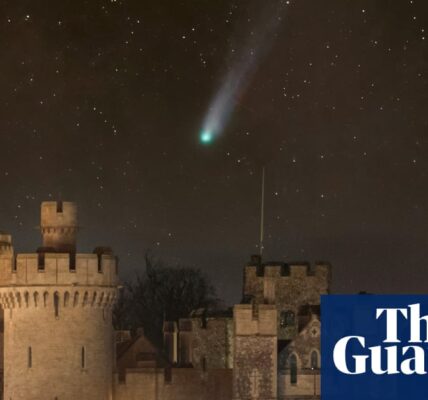‘It was like the wild west’: meet the First Nations guardians protecting Canada’s pristine shores
It’s Delaney Mack’s first time pulling crab traps and she is unsure what to do. Mack, the newest member of the Nuxalk Guardian Watchmen, has had months of training for the multifaceted job, which might on any given day include rescuing a kayaker, taking ocean samples or monitoring a logging operation. But winching crabs up 100ft from the sea floor was not in the manual.
Soon, however, the four-person operation is humming along. The crab survey is a vital part of their work as guardians of this Indigenous territory in the Canadian province of British Columbia. It was started more than 15 years ago in response to heavy commercial crab fishing in an area where the federal government had done little independent monitoring to determine if a fishery was sustainable.
It is the quintessential guardian assignment: remote monitoring work of immediate importance to a small community, far beyond the gaze of administrators at understaffed government agencies.
The watchmen are the eyes and ears of their First Nation community on the lands and water of their territory, which spans about 18,000 sq km (7,000 sq miles, roughly the size of Kuwait) on the central coast of British Columbia around the town of Bella Coola, 430 mountainous kilometres northwest of Vancouver.
For Mack, being chosen to join the guardians was a godsend. “I had no idea what I was going to do with my life,” she says.
Indigenous guardianship goes back millennia, but in recent decades has become more formally enshrined and recognised. Today there are about 1,000 guardians in 200 Indigenous communities across Canada, according to the Indigenous Leadership Initiative, a national guardian advocacy group.
A new layer has been added to the guardians’ authority: park ranger badges. As part of a pilot project launched last summer, five of the Nuxalk guardians and six of the Kitasoo/Xai’xais guardians to the north-west have been granted the power to issue tickets for offences such as poaching and illegal logging on their territory.

The programmes are about much more than creating jobs, although these are welcome in communities that are often remote and can be extremely impoverished. The teams carry out monitoring projects such as the crab survey; environmental DNA collection; and distress call responses that could take hours if left to distant authorities. This all reinforces the community’s own connection to, and claim on, its traditional territory.
Mack wears her uniform with pride, the only female full-time (albeit seasonal) member of the team. She says her father, who raised her with frequent trips out on the land, was proud to see her sign up. “When I showed up a few weeks ago with my brand new uniform, he congratulated me; he seemed very stoked,” she says. “He felt that it was very important work.”
‘I just want my daughter to enjoy all of this’
After the team pull up six crab traps, the first two prized Dungeness crabs show up. One, a huge male, has recently moulted – which Mack’s colleague, Charles Saunders, identifies by gently squeezing part of its carapace. While a third crewmate takes notes, Saunders rattles off a few other metrics, noting its size and approximate age, and then Mack tosses the impressive crab back into the ocean. Three more traps to go.
When it’s time for the guardians’ break, they’re still on the water, and Saunders reaches for a fishing pole.
Saunders and Mack are the same age, and went to school together. But while Mack took her time finding her way to the guardians, Saunders was quick to join up – though he maintains he was “tricked into this job” by his late mother, a skilled medicine woman who wanted him to have job security. She got what she hoped for: this year is his eighth as a guardian.
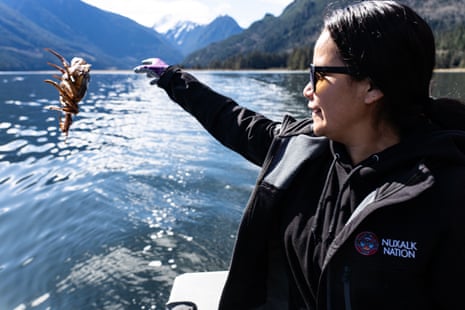
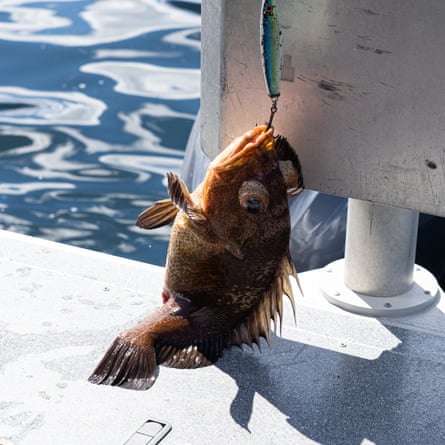
It’s not long before Saunders pulls up a big rockfish and puts his hook back in the water. It’s not for him, though. Later, on the way home, he runs into a home on the reserve and drops two fresh fish off with an Elder.
“She hadn’t had rockfish in, like, 20 years,” he says. “She doesn’t have anybody to go out and get those things for her.”
Saunders points out that it wasn’t long ago that most Nuxalk had access to boats. Villages were scattered up and down the nearby fjords, connected primarily by water, with rich tidal flats providing an abundance of foraging and hunting opportunities. After colonisation and its associated epidemics devastated the local populations, the Nuxalk became concentrated in Bella Coola, which sits at the head of a long sheer-sided fjord.
The town is only accessible by one road, which rises sharply from the humidity of the valley to an arid plane north-east of the mountains. The primary Nuxalk reserve is at the mouth of the river, where signs warn fishers not to throw entrails back into the slow-moving waters lest they attract grizzly bears.
The depopulation of so much of the area, on top of its remoteness from government power centres, has made it vulnerable. Douglas Neasloss, the chief of the Kitasoo/Xai’xais First Nation, had to confront this while working as an ecotourism guide at the start of the 2000s. “There were so many illegal activities in our part of the world: illegal hunting, illegal fishing – we even caught one guy doing illegal forestry.”
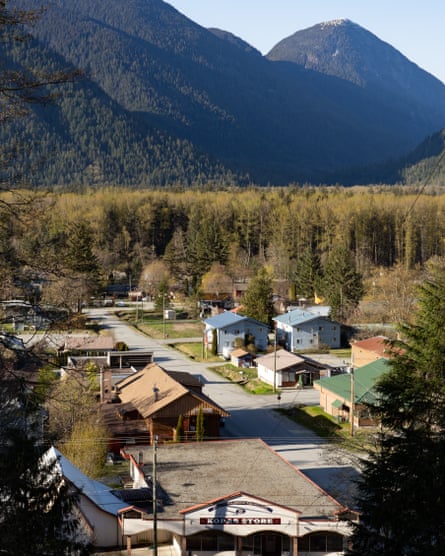
The Kitasoo/Xai’xais territory is directly adjacent to that of the Nuxalk, and both suffer from the same neglect by federal and provincial authorities.
“In the 90s, anybody knew that there was no law enforcement agencies up in this part of the world. We’re extremely remote, only accessible by boat or plane. And you will never see [provincial or federal government representatives],” he says. “It was like the wild west.”
Neasloss started the Kitasoo/Xai’xais Guardian Watchmen programme in 2010, funded by a combination of private and government money. The programme has grown to the point where it has five boats on the water doing everything from resource stewardship to coastguard operations – and Neasloss credits it with bringing illegal activities down to near zero.
Even in the pilot project here on the coast, guardians have yet to issue a single ticket. That’s fine with Neasloss. “I hope our guys never write a ticket, you know, and we focus a lot on the education piece.” It’s about getting results, not racking up fines, he says.
For Saunders, the way the guardians have tamped down the “wild west” mentality means they’re preserving what the Nuxalk depend on.
“I just want my daughter to enjoy all of this that I get to enjoy,” he says. “I want her to swim in the river [and] be able to harvest everything off the land.”
‘This uniform is the best one I have worn’
Some days are easier than others. Today, for instance, Roger Harris is on the water with his boss, Ernie Tallio, driving a boat in circles. The older of the guardians’ two boats has just had new engines installed, and they need to be broken in with two hours’ worth of running time, so Harris is at the helm, putting the boat through its paces.

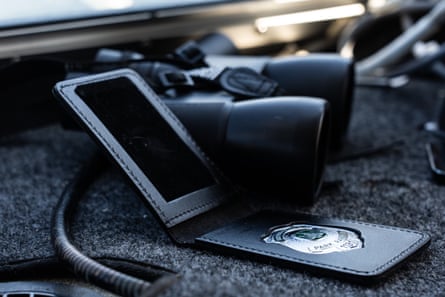
Harris was raised outside the Nuxalk community by non-Indigenous parents and used to struggle with his identity. “I used to be ashamed of being a First Nations child,” he says.
He became a paramedic, then a Royal Canadian Mounted Police officer and saw up close some of the problems in his community. Like his first call as a police officer, in which he responded to a classmate’s death by suicide. Or a young community member’s horrific car accident. In these cases, he had to set aside his identity and become the uniform he was in.
But the Nuxalk Guardian Watchmen uniform is “the best one I’ve ever worn”, he says.
That does not mean the job is without sharp edges. Another watchman, John Sampson, explains. “We’ve been called ‘native fish cops’ before,” he says, as we drive down toward the wharf. Indigenous and non-Indigenous people have sometimes responded to guardians’ interventions with hostility, derision or indifference.
But the role is directly beneficial to their communities. Harris, for example, regularly volunteers to patrol the community late into the night. Cruising slowly around the reserve in a white truck, pointing his spotlight into back yards, he could be mistaken for his former police officer self, but in fact he is looking for the grizzly bears that tend to be attracted by the fish-smoking shacks common in people’s gardens.

Men and women with badges and insignias can be triggering to local people who associate authority with oppression. There is a long history of disrespectful and demeaning things being done to Indigenous people in Canada, and a long trail of supreme court cases resulting from some of those interactions.
While there are no official plans yet, negotiations are under way with Fisheries and Oceans Canada to expand the guardians’ authority, giving them the power of federal fisheries officers. That would come with a much greater geographical area of responsibility beyond parks and conservancies – and, it could mean they would need to carry firearms and wear bulletproof vests.
For Neasloss, the potential Fisheries and Oceans Canada powers are part of a bigger plan, another step toward the ultimate goal of First Nations being able to enforce their own laws.
“I would love to see a First Nations recognised level of authority,” he says. “You know, as First Nations we say we have it – we’ve always had it, a stewardship responsibility – we’ve never surrendered that.”
Source: theguardian.com
